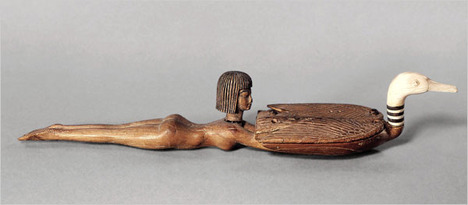 “Influences from Egypt and Mediterranean Asia appear to merge in this container, from around 1390 to 1352 B.C.” Source of caption and photo: online version of the NYT article quoted and cited below.
“Influences from Egypt and Mediterranean Asia appear to merge in this container, from around 1390 to 1352 B.C.” Source of caption and photo: online version of the NYT article quoted and cited below.
The cultural flowering (see above and below) brought about by Late Bronze Age Mediterranean trade, is highly compatible with arguments made in Tyler Cowen’s Creative Destruction, which argues that capitalism promotes the important kind of diversity that within cultures increases creativity and options for individual choice.
It would be interesting and useful to know more about the causes and effects of the dark age mentioned below–the one that started around 1200 BC. An earlier entry mentioned archeological evidence of a small family group near Katilimata on Crete who attempted to hunker down to defend themselves and their property from the invaders from the sea mentioned below.
Sometimes the Phoenicians are given credit for the trade, and Paul Johnson in his recent Heroes book (p. 4), identifies the evil invaders who killed the trade as being the Philistines.
(p. C28) For a truly cornucopian example of multiculturalism, though, nothing matches the contents of the Late Bronze Age merchant ship recovered from the sea off the southern coast of Turkey. Discovered by a sponge diver in 1984 and considered the oldest surviving example of a seagoing ship, it probably sank around 1300 B.C., packed with cargo representing a dozen cultures, from Nubia to the Balkans.
Although the ship’s home port is unknown, it appears to have traveled a circular route through the Mediterranean and Aegean, stopping in Greece, Crete, Turkey, Syria and Egypt, picking up and unloading as it went. Bulk materials included copper ingots, Cypriot pottery, African wood and Near Eastern textiles, all for waiting markets.
Divers also found luxury items, possibly personal possessions of the ship’s crew and passengers. Examples of ivory containers in the form of ducks have parallels with Egyptian prototypes, but were probably made in Mediterranean Asia. The two sources merge in a figure found in a tomb: a nude female swimmer with a chic, Nile-style pageboy who is hitching a ride behind an ivory-headed bird.
More precious and enigmatic is a standing bronze figure of a woman, probably a goddess, her head and face still covered with the sheet gold that may once have encased her whole body in a radiant epidermis. The exhibition catalog suggests that she might be a talismanic charm intended to protect the ship from harm.
Harm came anyway, as it did to much of the Mediterranean world, around 1200 B.C. with the arrival of mysterious, sea-based invaders, who conquered most of the great maritime cities, interrupting trade and easy cultural exchange, and bringing on a dark age, a depression. The depression — or was it severe recession? — didn’t last forever. The passion for acquisition, exchange and accumulation survived it, as it always does.
This passion is, of course, our own. It is one reason that we can, if we try, identify with the diverse people who, thousands of years ago, made the objects in this show. The globalist, all-in-it-together world model they invented is another reason. Their dark age could be one too.
For the full review, see:
HOLLAND COTTER. “Art Review; ‘Beyond Babylon’; Global Exchange, Early Version.” The New York Times (Fri., November 21, 2008): C23 & C28.
(Note: the online version of the review has the date November 20, 2008.)
The Cowen book mentioned in my initial comments, is:
Cowen, Tyler. Creative Destruction: How Globalization Is Changing the World’s Cultures. Princeton, NJ: Princeton University Press, 2002.
The Paul Johnson book mentioned in my initial comments, is:
Johnson, Paul M. Heroes. New York: HarperCollins, 2007.





 Source of table: "World Publics Welcome Global Trade — But Not Immigration." Pew Global Attitudes Project, a project of the PewResearchCenter. Released: 10.04.07 dowloaded from:
Source of table: "World Publics Welcome Global Trade — But Not Immigration." Pew Global Attitudes Project, a project of the PewResearchCenter. Released: 10.04.07 dowloaded from: 
 Ful is a fava bean stew that is popular in Cairo. Source of image: online version of the NYT article cited above.
Ful is a fava bean stew that is popular in Cairo. Source of image: online version of the NYT article cited above. George B. Kaiser. Source of photo:
George B. Kaiser. Source of photo: